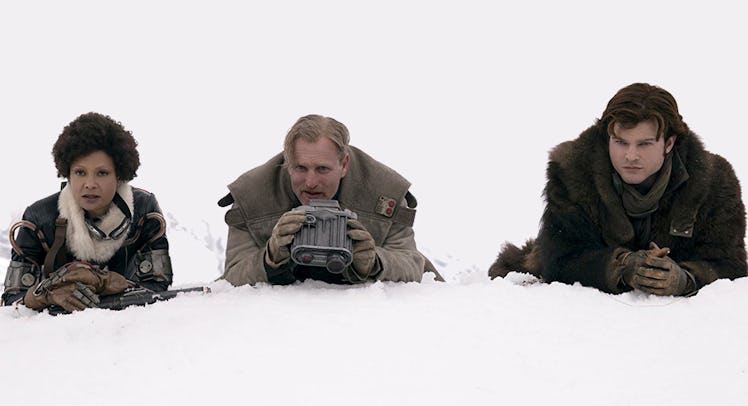Why Kids Will Be Explaining One ‘Solo’ Star Wars Cameo to Their Parents
The genuinely shocking cameo will only make sense to fans with an intimate knowledge of the 'Star Wars' television universe.

Although most Star Wars films are aimed at a younger audience, it’s not uncommon for parents who grew up with the movies to have to explain the trickier intricacies to their kids. Especially considering the films weren’t released in chronological order. But with Solo: A Star Wars Story, the reverse might be true. Older fans might be baffled by the sudden, shocking appearance of one character in particular. Kids who grew up on the newer Star Wars cartoons, on the other hand, will totally get it. Yep, there are spoilers ahead for ‘Solo.’ You’ve been warned!
After seeing Solo: A Star Wars Story this weekend, many fans are going to be asking the same question: Wait, isn’t Darth Maul dead already? And that’s because late in the film, Darth Maul (played by Ray Park and voiced by Sam Witwer) briefly shows up to establish his small but significant part in Solo’s plot. It’s weird and totally unexpected, but if you’re familiar with more contemporary Star Wars stuff, like the kids’ cartoons, you’ll get it. Here’s why.
In Solo, young Han (Alden Ehrenreich) teams up with a shady criminal crew lead by Tobias Beckett (Woody Harrelson) to steal some coxium, a rare, extremely valuable hyperfuel. They’re working for Dryden Vos (Paul Benatty), a dangerous crime lord. By the end of the movie, Han eventually decides to steal some of the coxium and bail on the mission, and he convinces Qi’ra (Emilia Clarke), his lifelong friend and romantic interest, to join him. However, when the time comes, Qi’ra stays behind and makes a hologram call to none other than Maul, who is revealed to be the big baddie somehow behind the whole operation. And in case there was any doubt it was Maul, he ignites his iconic double-bladed lightsaber just to let us all know he is definitely back.
The last time most Star Wars fans saw Maul, he was falling into an infinite abyss after being chopped in half by Obi-Wan Kenobi in 1999’s The Phantom Menace. That gruesome fate, combined with the fact that he was never mentioned again in the subsequent two films, led most to surmise that Maul had, in fact, kicked the bucket.
As it turns out, however, the Star Wars universe has been telling us for a while that he survived the bisection. Maul was revealed to be alive in a fourth season 2011 episode of the animated series The Clone Wars. He’s also popped up more recently on the Disney animated series Star Wars Rebels. In all of these appearances, he has robot legs. In Solo, those legs appear to be originals.
In The Clone Wars, Maul also became a prominent crime lord in the galaxy, forming the Shadow Collective – an alliance of criminal syndicates that includes the Hutt clan. Which, is why he’s a crime boss at the time of Solo!
The seemingly unkillable Maul again returns in Rebels, which takes place several decades after Clone Wars. At this point, the Sith Lord has been reduced to a shell of his former self and is solely focused on finding and killing Kenobi. He eventually tracks him to Tatooine, where the two battle for one last time, as Kenobi finishes the job and ends Maul once and for all. See, it totally makes sense. Just go binge all of The Clone Wars and Rebels right now if you don’t believe us.
The events of Solo take place between The Clone Wars and Rebels, meaning that somewhere between escaping an epic duel with Darth Sidious and ending up on the planet Malachor, Maul was able to once again establish himself as a prominent figure in the world of crime, albeit mostly in secret. How did this happen? It’s not entirely clear but Maul’s surprising appearance is clearly setting him up as a potential bad guy in a Solo sequel. Who knows? Maul might even end up getting his own spin-off film, where casual fans can finally learn the rich history of one of the greatest and most criminally underused villains in the entire Star Wars canon.
This article was originally published on